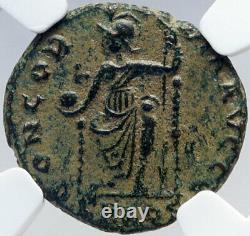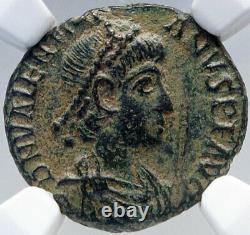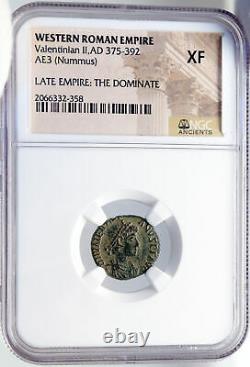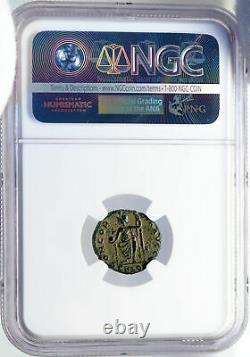
- Homepage
- Composition
- Denomination
- Ae Prutah (34)
- Ae3 (14)
- Antoninianus (104)
- Ar Denarius (42)
- Aurelianianus (12)
- Aureus (145)
- Bi Double Denarius (24)
- Bi Nummus (22)
- Centenionalis (16)
- Cistophorus (24)
- Denarius (1272)
- Double Denarius (63)
- Dupondius (16)
- Nummus (119)
- Prutah (27)
- Quadrigatus (13)
- Sestertius (127)
- Siliqua (15)
- Solidus (169)
- Tetradrachm (21)
- Other (604)
- Era
- Grade
- Ruler
- Antoninus Pius (53)
- Augustus (141)
- Caracalla (53)
- Constantine I (57)
- Constantine Ii (29)
- Domitian (58)
- Gallienus (37)
- Gordian Iii (62)
- Hadrian (100)
- Marcus Aurelius (69)
- Nero (113)
- Nerva (31)
- Philip I (66)
- Septimius Severus (36)
- Severus Alexander (69)
- Theodosius Ii (32)
- Tiberius (69)
- Trajan (97)
- Trajan Decius (28)
- Vespasian (76)
- Other (1607)
- Year
VALENTINIAN II Authentic Ancient 378AD Genuine Roman Coin w ROME ROMA NGC i82907






Item: i82907 Authentic Ancient Coin of. Bronze AE3 16mm Aquileia mint, struck 378-383 A. Reference: RIC IX 32c Certification: NGC Ancients. XF 2066332-358 D N VALENTINIANVS P F AVG, Pearl-diademed, draped and cuirassed bust right.
CONCORDIA AVG G G / SMAQS, Roma enthroned facing, helmeted and cuirassed, head left, holding globe and long spear. In ancient Roman religionn, Roma was a female deity who personified the city of Rome and more broadly, the Roman state. As personification, as goddess or as symbol, the name Roma stretches from classical Greece to Mussolini's Fascist propaganda... Roma has been seen as a goddess, a whore, a near-saint, and as the symbol of civilization itself. She remains the oldest continuous political-religious symbol in Western civilization.
Ronald Mellor, Introduction, The goddess Roma. The earliest certain cult to dea Roma was established at Smyrna in 195 BCE, probably to mark Rome's successful alliance against Antiochus III. Mellor has proposed her cult as a form of religio-political diplomacy which adjusted traditional Graeco-Eastern monarchic honours to Republican mores: honours addressed to the divine personification of the Roman state acknowledged the authority of its offices, Republic and city as divine and eternal. Democratic city-states such as Athens and Rhodes accepted Roma as analogous to their traditional cult personifications of the demos (ordinary people). In 189 BCE, Delphi and Lycia instituted festivals in her honour.
Roma as "divine sponsor" of athletics and pan-Hellenic culture seems to have dovetailed neatly into a well-established and enthusiastic festival circuit, and temples to her were outnumbered by her civic statues and dedications. In 133 BCE Attalus III bequeathed the people and territories of Pergamon to Rome, as to a trusted ally and protector.
The Pergamene bequest became the new Roman province of Asia, and Roma's cult spread rapidly within it. In Hellenistic religious tradition, gods were served by priests and goddesses by priestesses but Roma's priesthood was male, perhaps in acknowledgment of the virility of Rome's military power. Priesthood of the Roma cult was competed among the highest ranking local elites. In contrast to her putative "Amazonian" Roman original, Greek coinage depicts Roma in the "dignified and rather severe style" of a Greek goddess, often wearing a mural crown, or sometimes a Phrygian helmet.
In this and later periods, she was often associated with Zeus (as guardian of oaths) and Fides (the personification of mutual trust). Her Eastern cult appealed for Rome's loyalty and protection - there is no reason to suppose this as other than genuine (and diplomatically sound) respect. A panegyric to her survives, in five Sapphic stanzas attributed to Melinno. In Republican Rome and its Eastern colonae her cult was virtually non-existent.
Roma was thus absorbed into the earliest (Eastern) form of "Imperial cult" - or, from an Eastern viewpoint, the cult to Augustus was grafted onto their time-honoured cult to Roma. From here on, she increasingly took the attributes of an Imperial or divine consort to the Imperial divus, but some Greek coin types show her as a seated or enthroned authority, and the Imperial divus standing upright as her supplicant or servant. The Imperial cult arose as a pragmatic and ingenious response to an Eastern initiative. It blended and "renewed" ancient elements of traditional religions and Republican government to create a common cultural framework for the unification of Empire as a Principate. In the West, this was a novelty, as the Gauls, Germans and Celts had no native precedent for ruler cult or a Roman-style administration.
The foundation of the Imperial cult centre at Lugdunum introduced Roman models for provincial and municipal assemblies and government, a Romanised lifestyle, and an opportunity for local elites to enjoy the advantages of citizenship through election to Imperial cult priesthood, with an ara (altar) was dedicated to Roma and Augustus. Thereafter, Roma is well attested by inscriptions and coinage throughout the Western provinces. Literary sources have little to say about her, but this may reflect her ubiquity rather than neglect: in the early Augustan era, she may have been honoured above her living Imperial consort.
In the city of Rome itself, the earliest known state cult to dea Roma was combined with cult to Venus at the Hadrianic Temple of Venus and Roma. This was the largest temple in the city, probably dedicated to inaugurate the reformed festival of Parilia, which was known thereafter as the Romaea after the Eastern festival in Roma's honour. The temple contained the seated, Hellenised image of dea Roma - the Palladium in her right hand symbolised Rome's eternity.
In Rome, this was a novel realisation. Greek interpretations of Roma as a dignified deity had transformed her from a symbol of military dominance to one of Imperial protection and gravitas. Ruling in the East: Valens. Flavius Valentinianus (371 - 15 May 392), known usually by his anglicised name, Valentinian II, was a Roman Emperor from 375 to 392. Early Life and Accession (371-375).Flavius Valentinianus was born to Emperor Valentinian I and his second wife, Justina. He was the half-brother of Valentinian's other son, Gratian, who had shared the imperial title with his father since 367. He had three sisters Galla, Grata and Justa. The elder Valentinian died on campaign in Pannonia in 375.
Neither Gratian (then in Trier) nor his uncle Valens (emperor for the East) were consulted by the army commanders on the scene. Instead of merely acknowledging Gratian as his father's successor, Valentinian I's generals acclaimed the four-year old boy augustus on 22 November 375. The army may have been uneasy about Gratian's lack of military ability, and so raised a boy who would not immediately aspire to military command.
Gratian, forced to accommodate the generals who supported his half-brother, governed the trans-alpine provinces (including Gaul, Hispania, and Britain), while Italy, part of Illyricum, and Africa were under the rule of Valentinian. In 378, their uncle, the Emperor Valens, was killed in battle with the Goths at Adrianople, and Gratian invited the general Theodosius to be emperor in the East. As a child, Valentinian II was under the influence of his Arian mother, the Empress Justina, and the imperial court at Milan, an influence contested by the Catholic bishop of Milan, Ambrose.
Justina used her influence over her young son to oppose the Catholic party which was championed by Ambrose. In 385 Ambrose, backed by Milan's populace, refused an imperial request to hand over the Portian basilica for the use of Arian troops. In 386 Justina and Valentinian received the Arian bishop Auxentius, and Ambrose was again ordered to hand over a church in Milan for Arian usage. Ambrose and his congregation barricaded themselves inside the church, and the imperial order was rescinded.
Magnus Maximus used the emperor's heterodoxy against him, and even his eventual protector, Theodosius, cast aspersions on his Arianism. Valentinian also tried to restrain the despoiling of pagan temples in Rome. Buoyed by this instruction, the pagan senators, led by Aurelius Symmachus, the Prefect of Rome, petitioned in 384 for the restoration of the Altar of Victory in the Senate House, which had been removed by Gratian in 382. Valentinian, at the insistence of Ambrose, refused the request and, in so doing, rejected the traditions and rituals of pagan Rome to which Symmachus had appealed.
In 383, Magnus Maximus, commander of the armies in Britain, declared himself Emperor and established himself in Gaul and Hispania. Gratian died while fleeing him. For a time the court of Valentinian, through the mediation of Ambrose, came to an accommodation with the usurper, and Theodosius recognized Maximus as co-emperor of the West.
However, in 386 or 387, Maximus crossed the Alps into the Po valley and threatened Milan. Valentinian II and Justina fled to Theodosius in Thessalonica.
The latter came to an agreement, cemented by his marriage to Valentinian's sister Galla, to restore the young emperor in the West. In 388, Theodosius marched west and defeated Maximus. Although he was to appoint both of his sons emperor (Arcadius in 383, Honorius in 393), Theodosius remained loyal to the dynasty of Valentinian I. After the defeat of Maximus, Theodosius remained in Milan until 391.
Valentinian took no part in Theodosius' triumphal celebrations over Maximus. Valentinian and his court were installed at Vienne in Gaul, while Theodoisus appointed key administrators in the West, and had coins minted which implied his guardianship over the 17 year old. Justina had already died, and Vienne was far away from the influence of Ambrose. Theodosius' trusted general, the Frank Arbogast, was appointed magister militum for the Western provinces (bar Africa) and guardian of Valentinian. Acting in the name of Valentinian, Arbogast was actually subordinate only to Theodosius.While the general campaigned successfully on the Rhine, the young emperor remained at Vienne, in contrast to his warrior father and his older brother, who had campaigned at his age. Arbogast's domination over the emperor was considerable, and the general even murdered Harmonius, a friend of Valentinian suspected of taking bribes, in the emperor's presence. The crisis reached a peak when Arbogast prohibited the emperor from leading the Gallic armies into Italy to oppose a barbarian threat.
Valentinian, in response, formally dismissed Arbogast. The latter ignored the order, publically tearing it up and arguing that Valentinian had not appointed him in the first place.The reality of where the power lay was openly displayed. Valentinian wrote to Theodosius and Ambrose complaining of his subordination to his general.
In explicit rejection of his earlier Arianism, he invited Ambrose to come to Vienne to baptize him. However, on 15 May 392, Valentinian was found hanged in his residence in Vienne.Arbogast maintained that the emperor's death was suicide. While our main source, Zosimus writing in the early sixth century from Constantinople, states that the Frank had Valentinian murdered, ancient authorities are divided in their opinion. The young man's body was conveyed in ceremony to Milan for burial by Ambrose, mourned by his sisters Justa and Grata. The bishop's eulogy is the only contemporary Western source for Valentinian's death.
It is ambiguous on the question of the emperor's death, which is not surprising, as Ambrose represents him as a model of Christian virtue. Suicide, not murder, would make Ambrose dissemble on this key question.At first Arbogast recognized Theodosius's son Arcadius as emperor in the West, seemingly surprised by his charge's death. After three months, during which he had no communication from Theodosius, Arbogast selected an imperial official, Eugenius, as emperor.
Theodosius initially tolerated this regime but, in January 393, elevated the eight year old Honorius as augustus to succeed Valentinian II. Civil war ensued and, in 394, Theodosius defeated Eugenius and Arbogast.Valentinian himself seems to have exercised no real authority, and was a figurehead for various powerful interests: his mother, his co-emperors, and powerful generals. Since the Crisis of the Third CenturyDiocletian and his collegiate system.
While Constantine and his sons had been strong military figures, they had also re-established the practice of hereditary succession, adopted by Valentinian I. The obvious flaw in these two competing requirements came in the reign of Valentinian II, a child. His reign was a harbinger of the fifth century, when children or nonentities, reigning as emperors, were controlled by powerful generals and officials. World-renowned expert numismatist, enthusiast, author and dealer in authentic ancient Greek, ancient Roman, ancient Byzantine, world coins & more. Ilya Zlobin is an independent individual who has a passion for coin collecting, research and understanding the importance of the historical context and significance all coins and objects represent.
Send me a message about this and I can update your invoice should you want this method. Getting your order to you, quickly and securely is a top priority and is taken seriously here. Great care is taken in packaging and mailing every item securely and quickly. What is a certificate of authenticity and what guarantees do you give that the item is authentic? You will be very happy with what you get with the COA; a professional presentation of the coin, with all of the relevant information and a picture of the coin you saw in the listing.
Additionally, the coin is inside it's own protective coin flip (holder), with a 2x2 inch description of the coin matching the individual number on the COA. Whether your goal is to collect or give the item as a gift, coins presented like this could be more prized and valued higher than items that were not given such care and attention to. When should I leave feedback? Please don't leave any negative feedbacks, as it happens sometimes that people rush to leave feedback before letting sufficient time for their order to arrive. The matter of fact is that any issues can be resolved, as reputation is most important to me. My goal is to provide superior products and quality of service. How and where do I learn more about collecting ancient coins? Visit the Guide on How to Use My Store. For on an overview about using my store, with additional information and links to all other parts of my store which may include educational information on topics you are looking for.This item is in the category "Coins & Paper Money\Coins: Ancient\Roman: Imperial (27 BC-476 AD)". The seller is "highrating_lowprice" and is located in this country: US.
This item can be shipped worldwide.- Certification Number: 2066332-358
- Certification: NGC
- Grade: XF
- Ruler: Valentinian II
- Denomination: Denomination_in_description
- Year: Year_in_description

